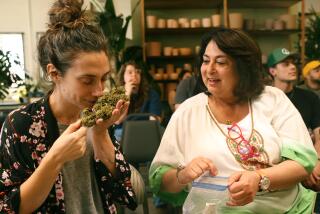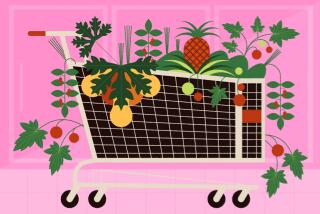Gardening : Garlic and Shallots Are Easy-Grow Taste Treats : Planting: Order select varieties or use bulbs you buy from the grocery store to grow your own pungent cooking spices.
- Share via
The bold flavor of garlic and the subtle flavor of shallots help transform ordinary table fare into extraordinary cuisine.
Both of these flavor favorites are easy to grow in a small kitchen garden plot or in a container. October is the choice month to plant them in the Southland. Once planted, you can almost forget about them. Except for regular watering, both garlic and shallots are almost carefree plants.
Garlic has been a prized culinary addition for thousands of years. Three thousand years ago in Egypt, one could purchase a slave for 10 pounds of garlic, and Roman soldiers and senators consumed copious quantities of the pungent bulbs.
You may order select garlic varieties from seed companies or you may simply buy garlic bulbs at the grocery store, pull them apart and plant the individual cloves. If you want a mild garlic, I would recommend elephant garlic.
It is usually available at nurseries and garden centers. Elephant garlic grows to a large size, sometimes producing bulbs which weight a pound or more, and it is a very reliable producer.
Garlic requires an area of the garden that receives full sun. Like all vegetables, garlic will benefit from a soil that has been well-worked and enriched with organic materials. Add a vegetable fertilizer at planting time.
Divide the garlic bulbs into individual cloves and plant them 1 inch deep, with the pointed ends up. Regular garlic should be spaced 3 inches apart and elephant garlic, 5 inches apart.
When planting garlic in rows, space the rows 15 inches apart. Garlic should be watered on a weekly basis until three weeks before harvest. During the growing period if any seed stalks form, break them off, as they hinder the bulb formation.
In late spring or early summer when the green foliage starts to droop and turn yellow, discontinue watering. When the tops turn brown and fall over, it is time to harvest the bulbs.
Dig the bulbs and let them dry in the sun for two days. Then let them cure in an airy place that is protected from the sun. When storing garlic bulbs, you may want to braid the stems to form clusters of bulbs and then store them in a dry, cool place that is adequately ventilated.
Shallots are the delight of the gourmet cook and are prized in French and other Continental cuisines. But they often are not carried by local markets, and when you do find them, they’re usually expensive. Why that is so isn’t known, since shallots are one of the easiest vegetables to grow.
They thrive on poor soil, need very little care and will divide and multiply year after year, producing clusters of small bulbs from the original bulb. These bulbs, when dried and cured, lend a mild garlic-onion flavor to meats, sauces and other dishes.
Shallot bulbs are available at many nurseries, or you can order them from firms such as Burpee Seed Co., 300 Park Ave., Warminster, Pa. 18991. You can also plant the shallots you buy in the market.
Soil preparation and cultural requirements for shallots are the same as those listed above for garlic. Plant the shallot bulbs 1 inch deep and 2 inches apart.
Shallots are ready for harvest when the tops turn brown and topple over. From a fall planting, this usually occurs in late spring. But be sure to leave a few bulbs in the ground to multiply and produce more plants. Pull the bulbs, leave the tops on, and cure them by letting them dry in the sun for one week. Then remove the tops and store the bulbs in a paper bag in a cool, dry area. Shallot bulbs will keep up to one year without losing their quality.
Both garlic and shallots are easy to grow in a container. When planting in a container, add a time-release fertilizer to the potting soil. Container-grown plants require more frequent watering. The soil should never be allowed to dry completely.






